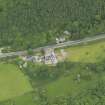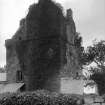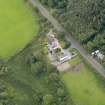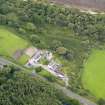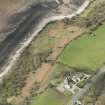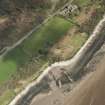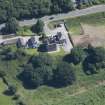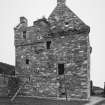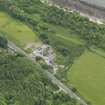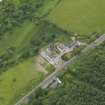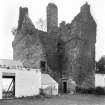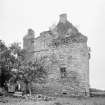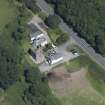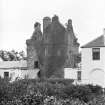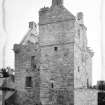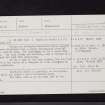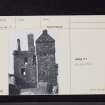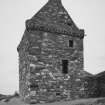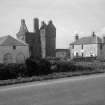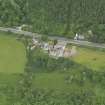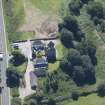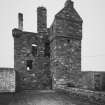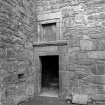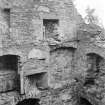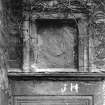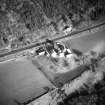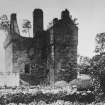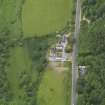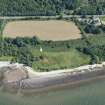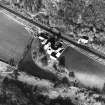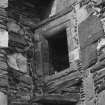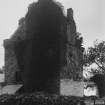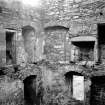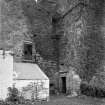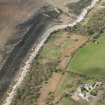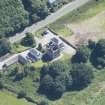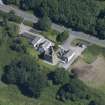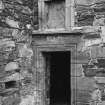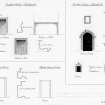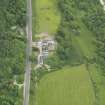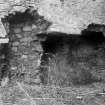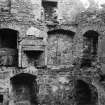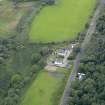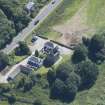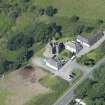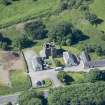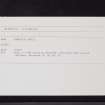Carsluith Castle
Tower House (Medieval)
Site Name Carsluith Castle
Classification Tower House (Medieval)
Canmore ID 63376
Site Number NX45SE 1
NGR NX 49464 54151
Datum OSGB36 - NGR
Permalink http://canmore.org.uk/site/63376
- Council Dumfries And Galloway
- Parish Kirkmabreck
- Former Region Dumfries And Galloway
- Former District Wigtown
- Former County Kirkcudbrightshire
NX45SE 1 4947 5416
(NX 4947 5416) Carsluith Castle (NR) (Remains of)
OS 6" map (1957)
Though now L-shaped, Carsluith Castle appears to have originally been a simple rectangular tower of 15th. century date. The stairtower to the N dates from 1568. The main block, now roofless, rose 3 storeys to a parapet and walk with corbelling. On the W jamb of the door leading from the farm court to the castle is a fragment of a Medieval cross slab in red sandstone.
RCAHMS 1914, visited 1912; N Tranter 1965.
Carsluith Castle is generally as described. The walls are intact. The cross slab is on the east jamb of the door.
Visited by OS (RD) 27 August 1970
NX 4947 5416 A watching brief was carried out on various dates in 2000 on service trenches in the vicinity of the 16th-century tower house (NMRS NX45SE 1). One trench exposed the remains of three walls enclosing a layer of shells and sand overlying ash, charcoal and iron slag. Finds were largely unstratified and are all post-medieval.
Sponsor: Packard Harrington for Kirkdale Estate.
J Brann 2001.
EXTERNAL REFERENCE:
R.I.B.A. Drawings collection
Elevation and details of entrance door and fireplace by A. Whiteford Anderson 1880.
Trans. of the Glasgow Archt. Asoc, 1902-6 - text & drawings
(Undated) information in NMRS.
Publication Account (1986)
Like Drumcoltran (no.31), this well-preserved four-storeyed tower presides over a later farm court. Also like Drumcoltran, its later wing demonstrates a trend in contemporary house design. Originally, this was a simple oblong tower of early 16th century date, and the upper floors were reached from a narrow staircontained in the north-west angle. The existing stairturret was added in 1568, the date and the armorial of the Brown family being carved on a panel above the entrance-doorway. A few corbels are all that remain of the early parapet on the north side-wall, although rather more of the original upperworks survive on the end walls. The gun-ports disposed around the ground floor of the main block were probably also inserted in about 1568.
Inside, the effects of the addition can be detected in the arrangement of intra-mural passages and chambers between the stair and main block. The tower otherwise conforms to the normal pattern: vaulted ground-floor cellarage, fIrst-floor hall, second-floor chambers with attic and caphouse over the stair. In this case there are two ground-floor vaults but no inbuilt kitchen. Food was probably prepared in an outhouse or in the hall itself where there is a slop-sink in the south-west corner; for dry preservatives the hall fireplace has a salt-box in one jamb. The two (bed) chambers on the second floor are of mirrored layout, the partition having formerly run between the paired latrines in the south wall.
Little is known of its history. Carsluith was Church land in the Middle Ages, and held until 1748 by the Browns, a family of Cumbrian origin. In 1579 a member of the family of John Brown, builder of the addition, probably his son, was implicated in the murder of his neighbour, John McCulloch of Barholm.
Information from ‘Exploring Scotland’s Heritage: Dumfries and Galloway’, (1986).































































